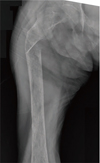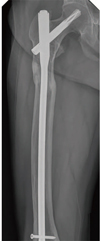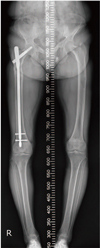Abstract
Brown tumor refers to a change of skeletones that develops as a complication of hyperparathyroidism. As osteoclast is activated to stimulate reabsorption and fibrosis of bone, it causes a cystic change of the bone. Parathyroid carcinoma is being reported as a tumor that induces primary hyperparathyroidism. It causes excessive secretion of the parathyroid hormone and increases the blood parathyroid hormone and calcium. Bone deformation due to brown tumor is known to be naturally recovered through the treatment for hyperparathyroidism. However, there is no clearly defined treatment for lesions that can induce pathological fractures developing in lower extremities. We experienced a case where brown tumor developed in the proximal femur of a 57-year-old female patient due to parathyroid carcinoma. In this case, spontaneous fracture occurred without any trauma, and it was cured by performing intramedullary nailing fixation and parathyroidectomy. We report the treatment results along with a literature review.
Brown tumor refers to a change of skeletones that develops as one of the complications of hyperparathyroidism, where cystic and fibrous changes of bone occur12). This is caused by the progression of reabsorption and fibrosis of bone following the activation of osteoclast and is sometimes referred to as osteoclastoma3). It is reported that approximately 10% to 20% of patients with hyperparathyroidism experienced brown tumor. The occurrence is particularly high among women in their 30s and 40s. Parathyroid carcinoma is a tumor, very rarely reported, that could induce primary hyperparathyroidism. It causes excessive secretion of the parathyroid hormone and increases the blood parathyroid hormone and calcium with the bone lesion, brown tumor. Generally, bone deformation due to brown tumor is known to be naturally cured through the treatment for hyperparathyroidism, regardless of the causes4). However, there is no clearly defined therapy for lesions that have very thin cortical bone in lower extremities which are different from upper extremities in the point of weight bearing. We experienced a case where a pathological fracture developed in the proximal femur of a patient with brown tumor so we report the treatment results along with a literature review.
A 57-year-old female patient came to the hospital with pain in both thighs, especially on the right side. The pain was exacerbated during weight bearing and walking and decreased while resting.
In the physical examination, there was direct tenderness in the right thigh and right groin region. But no edema or external abnormality was observed. The range of motion of the hip joint was normal, and there were no abnormal neurological findings. On the simple radiographic inspection, the cortical bone of the right proximal femur was thinned and showed cystic change. Decreased bone density was also observed and the trabecular bone of the overall femur was thinned (Fig. 1A). The magnetic resonance imaging (MRI) was performed on the part showing cystic bone change to determine the bone tumor. Lesions with a low signal in T1WI (Fig. 1B) and a high signal in T2W1 (Fig. 1C) were observed in the proximal femur on both sides and in the right pubis. Based on the MRI findings, brown tumor was suspected. An additional blood test was conducted and serum intact parathyroid hormone was 2,720 pg/mL (normal, 15-65 pg/mL), alkaline phosphatase was 2,417 U/L (normal, 104-338 U/L), calcium was 14.5 mg/dL (normal, 8.6-10.4 mg/dL), and phosphate was 2.0 mg/dL (normal, 2.6-4.4 mg/dL). To find out the cause of hyperparathyroidism, we did the ultrasonography of the thyroid. Since a nodule was observed in the left lobe of the parathyroid, fine needle aspiration was performed to obtain pathological results from the parathyroid. Furthermore as malignant change could not be excluded with the presence of a relatively large nodule, a parathyroidectomy was decided.
On the 14th day from admission, the day for parathyroidectomy, the patient felt sudden pain in the right thigh while getting up from a bed to sit down in the morning, and radiographic inspection was performed. In the femur anteroposterior and lateral images, a pathological fracture was confirmed in a site where the brown tumor had formed (Fig. 2). Closed reduction and internal fixation with the intramedullary nailing was performed in orthopaedic surgery department, and a biopsy was conducted using specimen tissue obtained during the medullary reaming. And the additional biopsy was performed along with the parathyroidectomy in the head and neck surgery department. The blood calcium concentration decreased to 10.0 mg/dL after the surgery, and the blood parathyroid hormone concentration became normalized after a month (Table 1). In a biopsy on the femoral lesion, brown tumor was diagnosed. The biopsy of the parathyroid confirmed the parathyroid carcinoma. Four months after the surgery, the union of the fracture was confirmed (Fig. 3). The patient became capable of walking without a crutch or walkers by a follow-up ten months after the surgery.
An increase of blood parathyroid hormone concentration due to hyperparathyroidism destroys the balance of osteoblasts and osteoclasts through activation of the osteoclast. As a result, bleeding and repetitive granulation of tissue partially develops in the bone, which is gradually filled with fibrous tissues which are rapidly proliferate. These changes of bone are observed in approximately 10% to 20% of patients with hyperparathyroidism and are referred as brown tumor35).
Brown tumor is a benign tumor that belongs to the giant cell tumor group. A cyst formed by the osteoclast function has clinical significance, as it increases pain and the risk of fracture. In radiological aspects, it is similar to a metastatic tumor which has an osteolytic lesion. The difference is that it does not invade adjacent tissues and does not induce changes around the periosteum124). In our case, an osteolytic lesion in the proximal part of the right femur was observed in simple X-ray. The cortical bone was thinned to approximately one-third the thickness of other parts of the bone. Multiple osteolytic lesions existed not only in the right proximal femur but also in the right acetabulum and left pubis. However, a periosteal reaction, which is frequently observed in cases of metastatic tumor, was not observed. With a high concentration of blood parathyroid hormone, a brown tumor due to hyperparathyroidism was diagnosed6).
As it was reported that osteolytic lesions caused by brown tumor are recovered when hyperparathyroidism is treated13), we decided to treat the hyperparathyroidism for the first, including a parathyroidectomy, instead of doing surgical therapy on the bone lesion. However, in this case, a fracture in the right femur occurred unfortunately without any trauma while the patient was bending her legs to sit up on a bed. Although she had mild pain, her bony lesion was located in a subtrochanteric site, and it showed severe cystic and osteolytic changes. There was an invasion of over two-thirds of the cortical bone thickness. The patient's Mirels score, which indicates the possibility of a pathological fracture development, was ten (Table 2)78). As we thought that recovery of bone lesions can be expected with therapy for hyperparathyroidism without prophylactic internal fixation so we did not undergo primary stabilization with intramedullary nail at first time. But through this case, it is assumed that it will still be necessary to actively do the preventive fixation by applying the Mirels score, as brown tumor is in lower extremities which is the weight bearing portion and could easily induce pathological fracture.
In our case, there were other bone lesions except the right femur lesion. Through the treatment for hyperparathyroidism, her pain on groin and left thigh region were relieved clinically and osteolytic bony changes in pubis and left proximal femur were recoverd by the follow up X-ray after ten months from the diagnosis (Fig. 4). The blood parathyroid hormone and calcium concentration were normalized within a few days after the parathyroidectomy.
In conclusion, as brown tumor due to hyperparathyroidism has a characteristic of multiple osteolytic lesions, if there were multiple osteolytic lesions in plain X-ray film, hematological tests including blood calcium and parathyroid hormone concentration are required for differential diagnosis. When a brown tumor does not accompany the pathological fracture, conservative treatment should be considered first. However, we believe that it will be necessary to prophylactic internal fixation according to the Mirels score in case of a high risk of fracture, as in our case.
Figures and Tables
Fig. 1
X-ray findings at the time of hospital visit. (A) Osteolytic lesion in right proximal femur and left femur were observed. On pelvis magnetic resonance image, the signal of brown tumor was low in T1WI (B) and high in T2WI (C).

References
1. Ullah E, Ahmad M, Ali SA, Redhu N. Primary hyperparathyroidism having multiple Brown tumors mimicking malignancy. Indian J Endocrinol Metab. 2012; 16:1040–1042.

2. Bassler T, Wong ET, Brynes RK. Osteitis fibrosa cystica simulating metastatic tumor. An almost-forgotten relationship. Am J Clin Pathol. 1993; 100:697–700.

3. Radulescu D, Chis B, Donca V, Munteanu V. Brown tumors of the femur and pelvis secondary to a parathyroid carcinoma: report of one case. Rev Med Chil. 2014; 142:919–923.

4. Hsieh MC, Ko JY, Eng HL. Pathologic fracture of the distal femur in osteitis fibrosa cystica simulating metastatic disease. Arch Orthop Trauma Surg. 2004; 124:498–501.

5. Emin AH, Süogğlu Y, Demir D, Karatay MC. Normocalcemic hyperparathyroidism presented with mandibular brown tumor: report of a case. Auris Nasus Larynx. 2004; 31:299–304.

6. Hoshi M, Takami M, Kajikawa M, et al. A case of multiple skeletal lesions of brown tumors, mimicking carcinoma metastases. Arch Orthop Trauma Surg. 2008; 128:149–154.

7. Jawad MU, Scully SP. In brief: classifications in brief: Mirels' classification: metastatic disease in long bones and impending pathologic fracture. Clin Orthop Relat Res. 2010; 468:2825–2827.




 PDF
PDF ePub
ePub Citation
Citation Print
Print







 XML Download
XML Download